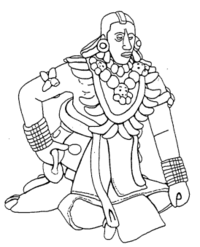Ch'ak Tz'oj
This article is incomplete because it is pending further input from participants, or it is a work-in-progress by one author. Please comment on this article's talk page to share your input, comments and questions. Note: To contribute to this article, you may need to seek help from the author(s) of this page. |
Ch'ak Tz'oj (Mutli: ఛక ఝొహ, 'Lightning Boxing'), sometime also known as Mutulese Boxing, is a Combat sport and Martial arts originating from the Mutul. It involve the use of two weapons: the Shield, made out of stones, in the left hand and the Conch in their right hand. Ch'ak Tz'ojom have a very distinctive appearance as they wear heavy padding around their face, hips, and thighs as protection. In the Mutul, Ch'ak-Tz'oj governing body is the W'ajtun Tribunal based out of the W'ajtun Temple in K'alak Muul north-eastern suburbs. The W'ajtun Tribunal register boxers, train referees, and leave the organisation of competitions and individual matches to independent Promoters, venues, patrons, and hosts of various sorts. At the professional level, the major competitions are the W'ajtun Martial Festival, the Nuu Davi Boxing Championship, and the Yopaat International Championship, each organized by a different federation. Individual matches and smaller scale competitions are also regularly organised during festivals or holy days by municipalities, Social club, or Gambling Venues as a form of entertainment.
Ch'ak Tz'oj is actually only one style of combat in the galaxy of related Mutuleses Martial Arts. However, it outshine all other forms in sheer popularity and funding, to the point it is often considered the second most popular and watched sport in the Mutul after Pitz although due to the more diffuse nature of its organization and practice, it is difficult to gather reliable numbers of both practitioners and spectators outside of the W'ajtun Tribunal' registries.
Equipment
Shield
The Pakal is one of the two main weapons of the Ch'ak Tz'ojom. These are cloths or leather covering a hand-held heavy stone. Carved from a single piece of stone, the Pakal is pierced with a large hole to accomodate the hand while the principal, spherical, mass cover the knuckles. Almost every ruleset mandate that the Shield is to be wore only on the left hand.
While originally a weapon in its own right, under the current W'ajtun Ruleset obeyed by almost every competition held in the Mutul the Pakal is not used as such. It is actually use as protection, to deflect incoming Conch strikes. It can still be used in an offensive manner, but it is illegal to strike an opponent in a non-padded area as well as to perform a direct strike to the face with the Pakal. When performed as a martial art rather than as a sport, Ch'ak Tz'ojom still teach those strikes but great precautions are to be taken during training and practice.
Conch
The Juch, literally 'the Conch', was historically indeed the shell of a large mollusk used as a weapon by Mutuleses boxers. Nowadays, the Juch is a brass or iron forged spiked knuckles daggers. It is always worn on the right hand and is the main weapon of a Mutulese Boxer due to how the N'ajtun Ruleset handle scoring: "He who draw first blood win the round. He who first win three rounds win the Bout." A well placed Juch strike in a non-protected area of the opponent is thus the only way for a Boxer to score.
With time, the Conch has become the very emblem of the sport, moreso than the shield, and is recognized internationally. It's generally a symbol of the martial art' bloodiness and violence (despite being less dangerous to a fighter than the Shield) but also of its technicity and emphasis on speed over power.
Rules
Rules of Ch'ak Tz'oj are dictated by the W'ajtun Tribunal and applied by their Referees. They are famously ingraved on the Standing Stones outside of the Tribunal' Temple, alongside other monuments dedicated to legendary boxers. According to these rules and regulation, Ch'ak Tz'oj is a martial art that uses every part of the body's limbs, therefore allowing for strikes including the fists, legs, knees and elbows, and every part of the body is a valid target with the exception of the Pakal, the Shield, which can only be used to strike protected areas of the fighters and never aimed directly at the face (which implicitly allows for jabs to the heavily padded cheeks.
The main specificity of Ch'ak Tz'oj is that none of those strikes count toward the final score. A boxing bout is divided into rounds, and as per the W'ajtun ruleset the first boxer to win three rounds win the bout. To win a round, a boxer must draw blood, no matter the ammount or the size of the wound. While the rules do not specify how the fighters are supposed to draw blood, the easiest way to do so is by using their Conchs.
Protected areas are also defined by the Ruleset and include: the head (padded helmet and leather mask), the hands, (Conch and Shield), the Hips (Rubber pads), and Tighs (padded leather shorts). Protections in unregistered matches that do not follow the W'ajtun ruleset may differ widely, with the abdomen and feet being added as Protected Areas or instead with the entire body being left unprotected.

